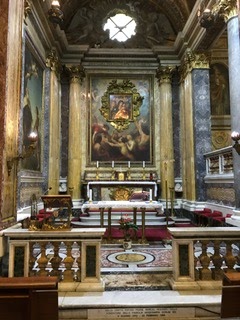This is the place in which the Nicean Creed was first said... There is a mural commemorating the moment...

From PNAC.org
With our mind’s eye we imagine the pillar of smoke billowing out of a roaring fire, into which scrolls are being thrown, while the pope and clergy of the city look on, their faces illuminated by the blaze. This was the scene at this location in 326 when the works of Arius and other theologians condemned at Nicea I were burned, a public sign of their rejection by the Church. Tradition holds that the first place of Christian worship on this site was in the house of a priest named Equitus, after whom the titulus would later be called upon its foundation by St. Silvester in the early fourth century. This was the location for both the preparatory meeting of the Roman clergy, in which they prepared their statement of faith for Nicea I, as well as the subsequent reception of the decrees of the council and carrying out of the destruction of the works of those there condemned. Tradition passes down that a basilica in honor of St. Martin of Tours was built nearby in the late fifth century. Later some older buildings nearby were converted into a church named after St. Silvester. St. Silvester I became pope in 314, just after the legalization of Christianity. He oversaw the construction of the Lateran basilica and the other early churches built after the Edict of Milan. Along with this he helped in the development of the liturgy in the city, including in the preparation of the martyrology. He also supported the orthodox belief in the Arian crisis.

From PNAC.org
With our mind’s eye we imagine the pillar of smoke billowing out of a roaring fire, into which scrolls are being thrown, while the pope and clergy of the city look on, their faces illuminated by the blaze. This was the scene at this location in 326 when the works of Arius and other theologians condemned at Nicea I were burned, a public sign of their rejection by the Church. Tradition holds that the first place of Christian worship on this site was in the house of a priest named Equitus, after whom the titulus would later be called upon its foundation by St. Silvester in the early fourth century. This was the location for both the preparatory meeting of the Roman clergy, in which they prepared their statement of faith for Nicea I, as well as the subsequent reception of the decrees of the council and carrying out of the destruction of the works of those there condemned. Tradition passes down that a basilica in honor of St. Martin of Tours was built nearby in the late fifth century. Later some older buildings nearby were converted into a church named after St. Silvester. St. Silvester I became pope in 314, just after the legalization of Christianity. He oversaw the construction of the Lateran basilica and the other early churches built after the Edict of Milan. Along with this he helped in the development of the liturgy in the city, including in the preparation of the martyrology. He also supported the orthodox belief in the Arian crisis.
Both of these early churches were replaced by the current basilica under Pope Sergius II (r. 844-847). Although it is dedicated to Ss. Silvester and Martin, combining the two titles of the earlier basilicas, it is now more commonly known as St. Martin’s on the Mount. At this time the relics of many martyrs were translated here, being placed in the confessio beneath the high altar. This basilica, restored in the mid-sixteenth century, was more extensively renovated a century later. During this time the church and confessio were completely redecorated in the fashion of the day. The current façade was completed somewhat later, in 1676, although some small parts of the earlier one remain. The Carmelite Order is first mentioned as serving here in the fourteenth century, with their service here continuing to the present time.
On the left side of the nave is a statue of St. Sylvester I in council at this location, discussing the events surrounding the Council of Nicea . It is interesting to note that, although this meeting would have taken place in the early 4th century, the participants are dressed in 17th century clothing. In the back of the church there is another image of what the interior what of St. John Lateran would have looked like.










No comments:
Post a Comment